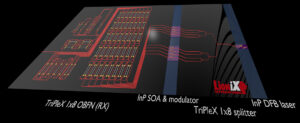ABOUT THIS PROJECT:
5G-PHOS is a H2020 5GPPP Phase II project focusing on 5G integrated Fiber-Wireless networks that leverage existing photonic technologies towards implementing a high-density SDN-programmable network architecture. The project has a duration of 3 years, from 01/09/2017 until 31/08/2020, comprising a consortium of 16 partners and coordinated by Aristotle University of Thessaloniki. 5G-PHOS steps in to invest in and exploit integrated optical technologies towards enhancing Fiber-Wireless (FiWi) convergence and realizing cost-effective and energy-efficient 5G network solutions for high density use cases.
5G-PHOS is the first coordinated attempt that will draw from existing scientific results in the area of photonics in order to architect 5G networks for dense, ultra-dense and Hot-Spot areas incorporating Photonic Integrated Circuits (PICs) in optical mmWave signal generation, DSP-assisted optical transmission, reconfigurable optical add/drop multiplexing (ROADM) and optical beamforming functionalities. 5G-PHOS expects to release a seamless, interoperable, RAT-agnostic and SDN-programmable FiWi 5G network that supports 64×64 MIMO antennas in the V-band.
THE ROLE OF LIONIX INTERNATIONAL:
LioniX International contributes its expertise to this project mostly focused on technical aspects. This includes fabrication of optical chips, providing packaging expertise and test-and-validation processes. The optical system for this project is a so-called Optical Beam Forming Network (OBFN), which is connected to an antenna array, and employed to provide beam forming (beam shaping and beam steering).
The OBFN consists of three parts: active chips in InP, passive chips in TriPleX® and packaging. The passive chips will provide tunable true-time delay and phase shifts, required for flexible beam forming. The TriPleX® will be connected via end-facet-coupling to InP-based lasers, high-speed modulators, optical amplifiers and high-speed detectors. The combination of these passive and active chips provide a unique and very powerful microwave photonic processing engine to fully control antennas’ emission patterns in a way that is very challenging to achieve using electronics only.



